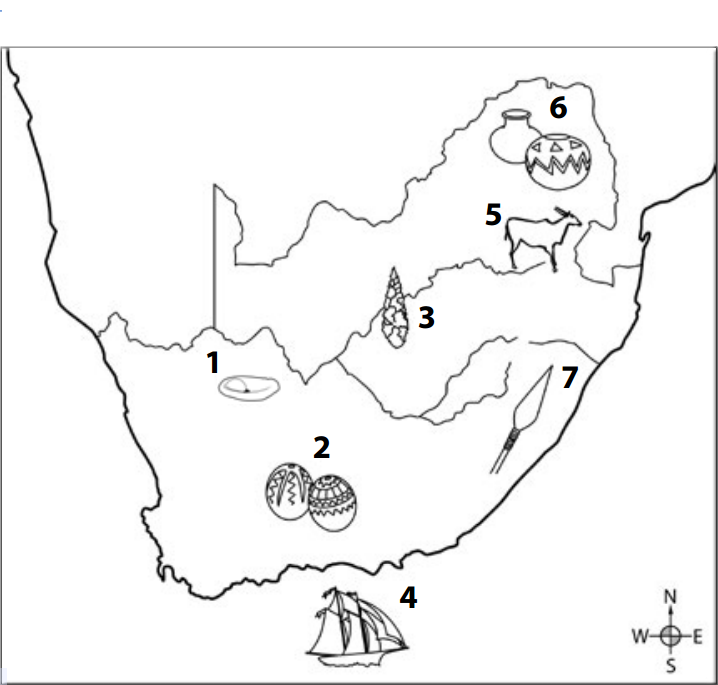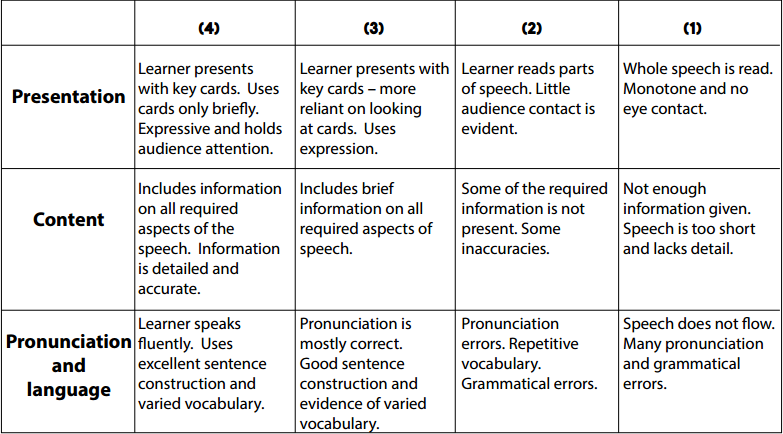Activity: Learning about the farmers
Archaeologists found a lot of information from their research surrounding Suikerbosrand and Hartebeespoort Dam near Johannesburg.
They discovered:
- Clay pots
- Stones used for grinding
- Remains of huts made from clay and built in a circle around a cattle pen
- Furnaces for smelting iron used for tools
- Dung-lined pits used to store grain
Look at the map below. The map shows only a few examples and evidence of the earliest inhabitants that archaeologists discovered. Link each description with the correct number on the map:

- These pots have existed since approximately 250AD. They were found in Mpumalanga and KwaZulu-Natal.
- Iron implements such as these date back to 700AD.
- The Portuguese navigator, Diaz, landed at Mossel Bay in 1488.
- Ostrich eggshells dating back 15000 years ago were found. The eggshells were usually buried near water.
- Hollowed-out stones that were used up to 10000 years ago were found at various sites.
- Some of the world’s largest collections of rock art works were found in the Drakensberg.
- Stone implements dating back 300000 years are found throughout South Africa.
Activity: Presentation
Using the information about the items that archaeologists discovered and what you have learned about the homesteads and villages of early farmers, draw a poster of a village scene to show how the farmers lived. Use your poster as the framework to present an oral in which you must explain how early farmers lived. Use the assessment rubric below to assist you when preparing your oral presentation.

Source: http://e-classroom.co.za/wp-content/uploads/2014/04/EngGr5T2-SS-History-Learner-Book.pdf
Activity: Social, political and economic structures
Roles of men, women, boys and girls.
The extended family was an important part of society during this time. People did not move around very much; families were large and children had parents, aunts, uncles and grandparents all living very close to one another. As a result, the division of labour was clearly marked. The men took the job of looking after the cattle and fighting off raiders and predators. The men were also skilled carvers and they made tools out of iron. They were skilled hunters and used assegais and knobkerries to hunt game. They also had to prepare the land to plant crops. The men built houses and took part in politics and public affairs. The boys helped their fathers with the cattle and building huts. They learned fighting skills through stick-fighting games. The boys had to be initiated before they could become adults. They had to survive on their own in the veld for three or four months.
The women were expert weavers and basket makers. They also tended the crops that the family had planted. They fetched water and firewood. They gathered food such as wild fruit and berries, shrubs and herbal plants, and made beer from the fruit of the marula tree. They also cooked the food and cared for the children. The women made pottery for cooking and storing food. The girls helped their mothers with chores around the home. At the age of thirteen, they went through initiation, which lasted a week. During initiation girls were separated from the rest of the tribe
Using the information you have learned, tabulate the different roles of the men, woman, boys and girls.
Men |
|
Boys |
|
Women |
|
Girls |
|
Activity: Comparison
Compare the people of early Southern Africa. Copy this table into your workbook. Compare the San, Khoikhoi and the early African farmers.
| San | Khoi-Khoi | African Farmers |
How did they live? |
|
|
|
Were they nomadic? |
|
|
|
What did they eat? |
|
|
|
How did they make their homes |
|
|
|
Additional activities
- Design a pamphlet that advertises a tour of the ruins of a kraal. Ensure that you include the date and time the tour will take place, possible sightings and items that will be viewed. Make your pamphlet as eye-catching as possible, using bright colours and clear wording.
- Using the knowledge you have of the homesteads and villages of the early farmers, construct a model of the layout of a kraal, illustrating how the early farmers lived. Where possible, use recycled items for your model.
- You are an archaeologist who has just discovered a new site. You have uncovered items that indicate the area was a kraal that was inhabited by the early farmers. Write a diary entry, explaining your excitement about the new discovery and what you hope to uncover in the near future.
- Write a set of instructions for a beginner who wants to learn how to extract iron from rock. You will need at least four instructions.